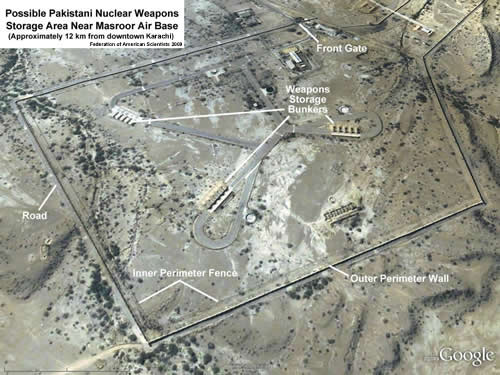 |
| A high-security weapons storage area northwest of Karachi appears to be a potential nuclear weapons storage site. (click image to download larger version) |
By Hans M. Kristensen
Pakistan’s nuclear weapons stockpile now includes an estimated 70-90 nuclear warheads, according to the latest Nuclear Notebook published in the Bulletin of the Atomic Scientists. The estimate is an increase compared with the previous estimate of approximately 60 warheads due to Pakistan’s pending introduction of a new ballistic missile and cruise missiles.
The increase in the warhead estimate does not mean Pakistan is thought to be sprinting ahead of India, which is also increasing its stockpile.
Modernizations
The nuclear-capable Shaheen-II medium-range ballistic missile appears to be approaching operational deployment after long preparation. The Army test-launched two missiles within three days in April 2008, and the U.S. Air Force National Air and Space Intelligence Center (NASIC) reported in June 2009 that the weapon “probably will soon be deployed.”
Two types of nuclear-capable cruise missiles are also under development; the ground-launched Barbur and the air-launched Ra-ad. The development of cruise missiles with nuclear capability is interesting because it suggests that Pakistan’s nuclear weapons designers have been successful in building smaller and lighter plutonium warheads.
Warhead Security Concerns
An article published in the July issue of the CTC Sentinel news letter of the Combating Terrorism Center at the U.S. Military Academy at West Point gained widespread attention for describing terrorist attacks against three of Pakistan’s rumored nuclear weapons facilities: Wah Ordnance Facility, Kamra Air Base, and Sargodha Weapons Storage Facility. Although the incidents had been reported before, the article triggered the predictable rejection from a Pakistani military spokesman but with the additional claim that neither facility stored nuclear weapons. “These are nowhere close to any nuclear facility,” he said. Yet the official would most likely not disclose the location of the nuclear weapons, even if he knew where they were.
While the CTC Sentinel article says “most” of Pakistan’s nuclear sites might be close to or even within terrorist dominated areas, senior U.S. officials said the weapons were secure and mostly located south of Islamabad.
Regardless of the actual location of the weapons, there have, of course, been many more terrorists attacks against other facilities that have nothing to do with Pakistan’s nuclear weapons program, and so far no pattern has emerged in public of a concerted terrorist effort against nuclear sites – much less an attempt to steel nuclear weapons. A U.S. intelligence official commented to the New York Times that it was unclear whether the attackers knew what the facilities contained. “If they were after something specific, or were truly seeking entry, you’d think they might use a different tactic, one that’s been employed elsewhere – such as a bomb followed by a small-arms assault.”
Pakistani and U.S. statements about the Pakistani nuclear arsenal, and the basis for our estimate, are included in the Nuclear Notebook.
Publication: Pakistani Nuclear Forces, 2009
The FY2026 National Defense Authorization Act (NDAA) paints a picture of a Congress that is working to both protect and accelerate nuclear modernization programs while simultaneously lacking trust in the Pentagon and the Department of Energy to execute them.
While advanced Chinese language proficiency and cultural familiarity remain irreplaceable skills, they are neither necessary nor sufficient for successful open-source analysis on China’s nuclear forces.
Satellite imagery has long served as a tool for observing on-the-ground activity worldwide, and offers especially valuable insights into the operation, development, and physical features related to nuclear technology.
This report outlines a framework relying on “Cooperative Technical Means” for effective arms control verification based on remote sensing, avoiding on-site inspections but maintaining a level of transparency that allows for immediate detection of changes in nuclear posture or a significant build-up above agreed limits.